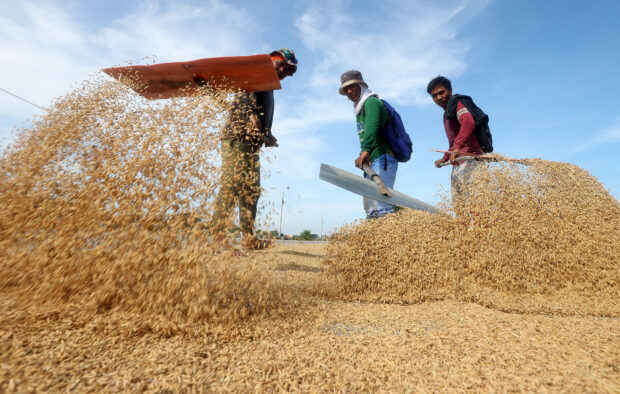Unmilled rice output forecast to hit record high this year

BUMPER HARVEST SEEN | Farmers take advantage of the sunny weather to dry their harvest of palay in Apalit town, Pampanga province. (File photo by NIÑO JESUS ORBETA / Philippine Daily Inquirer)
MANILA, Philippines — Despite the El Niño phenomenon, an official of the Department of Agriculture (DA) is projecting palay (unmilled rice) production to reach 20 million metric tons (MT) this year, the highest in the Philippines if achieved, due to better harvest conditions.
Agriculture Undersecretary Leocadio Sebastian said that assuming the same production scenario, the DA believes it is “still possible this time” to exceed the volume of palay produced in 2022 as a result of higher yields in the first six months.
“Hopefully, we will reach 20 million metric tons. If not, we’re just a little short of that,” Sebastian said.
Sebastian attributed the rosy outlook to the current harvest season, which he described as “fine,” adding that no strong typhoon has hit the Philippines so far, “only heavy rains and pest outbreaks in some areas.”
He told reporters that the DA was assessing the impact of Typhoon Egay (international name: Doksuri) on the agriculture sector, particularly rice, and other weather disturbances that hit the country this year.
The agriculture sector sustained P4.66 billion in losses due to the combined effects of Egay and Typhoon Falcon (international name: Khanun), which wiped out P1.79 billion worth of rice, or almost 40 percent of the total losses.
READ: Marcos says price cap helped stabilize rice prices
READ: Bongbong Marcos: New tech needed to tackle unstable rice prices
READ: Double-edged sword: The costs of controlling rice prices
Cropping season adjustment
To maximize production, the DA is in coordination with the National Irrigation Administration to study the adjustment of the cropping season as part of “huge reforms” in the rice sector, according to Agriculture Undersecretary Mercedita Sombilla.
“If they’re able to shift the planting season twice in the dry season, the yields are very much higher than during the wet season,” Sombilla said.
Palay output reached 9.03 MT in the first semester of 2023, up by 3.4 percent from 8.7 million MT in the same period a year ago, based on data from the Philippine Statistics Authority.
The January to June production represents 45.7 percent of the 19.76 million MT of the output recorded the previous year. However, last year’s production is lower than the record high of 19.96 million MT attained in 2021.
Earlier, Sebastian said the initial palay harvest from the provinces of Isabela, Nueva Ecija, and North Cotabato, estimated at 900,000 MT, would augment domestic supply and stabilize prices.
In a statement, the Presidential Communications Office quoted Sebastian as saying that the initial harvest of palay from the current wet season would occur until September.